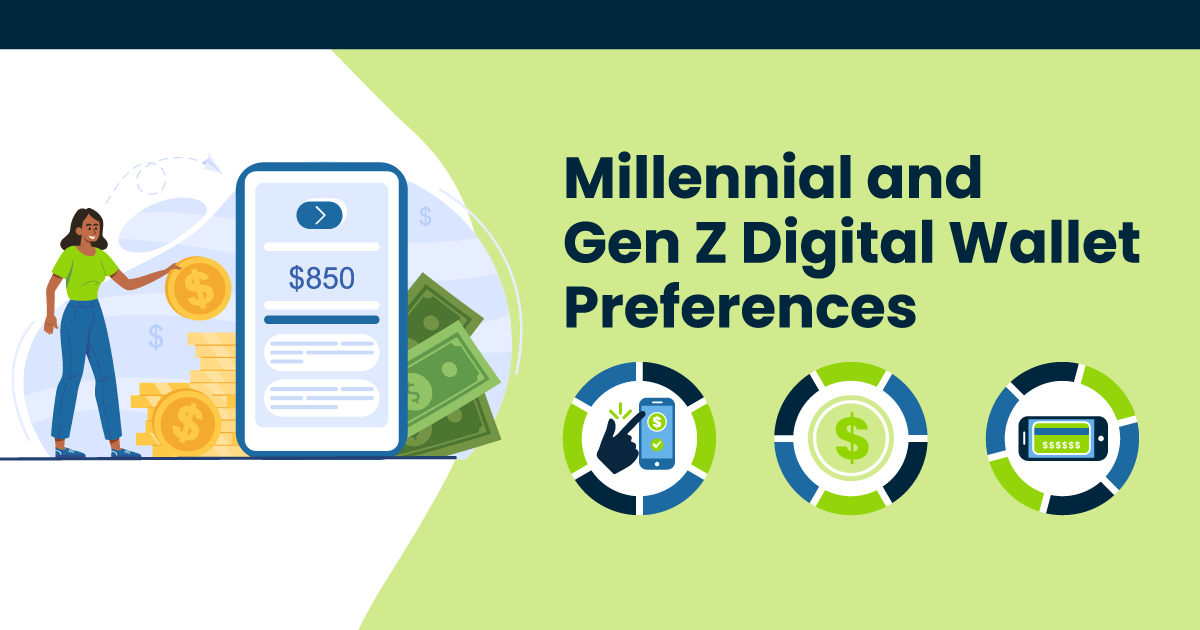
Millennial and Gen Z Digital Wallet Preferences
Those who have grown up with technology expect a certain level of convenience and instant gratification. Traditional payment methods fall short. Millennial and Gen Z consumers want modern options and digital wallets fit the bill.
Payment Methods Have Changed
In a FinanceBuzz1 survey, 59% of Millennials said they’d written a check in the last six months. This may seem surprisingly high, but keep in mind that the oldest Millennials were born in 1981, according to Pew Research2, meaning they turn 42 in 2023.
In contrast, many younger people, including younger Millennials and Gen Zers, don’t use checks at all. In fact, NerdWallet3 says 48% of Gen Zers have never written a check.
The same NerdWallet survey found that 44% of Gen Zers have never applied for a credit card and 25% had never visited a physical bank location to handle personal banking.
Times have changed – including payment methods.
Other Payment Options Leave a Lot to Be Desired
Writing a check can be a hassle. First, you need to have paper checks on hand. Then, you have to write the check, mail it and wait for it to clear. For younger consumers who expect instant, paperless transactions, paying or receiving payments by check is like using a corded phone on a wall. It’s antiquated.
Using a credit or debit card online may seem easier. After all, there’s no paper involved and you don’t have to depend on the mail. However, you still have to enter a 16-digit card number, a four-digit expiration date, and a three-digit CVV Number – that’s 23 digits before you even get to your ZIP code and billing address.
The process might seem reasonable compared to the hassle of using paper checks, but most young consumers expect even greater convenience.
Digital Wallets Offer the Convenience Young Consumers Crave
If checks and cards are out, what’s in? The answer is digital wallets.
According to Investopedia4, digital wallets are applications that run on mobile devices, laptops or computers. Also called electronic wallets, digital wallets can store many types of information, including bank accounts, credit cards, debit cards, gift cards, tickets, hotel reservations and driver’s licenses.
If you have a digital wallet on your phone, you don’t need to carry around cards or other pieces of information that are stored on the app – all you need is your phone. Digital wallets also facilitate fast, contactless payments.
There are several digital wallets available, including PayPal®, Google Pay™, and Apple Pay®.
Digital Wallets Are Catching On
Any new technology will take some time to catch on, but many people are already embracing digital wallets. Just how many?
Juniper Research5 reports that the number of digital wallet users globally in 2022 was already at 3.4 billion and predicts that 60% of the global population – more than 5.2 billion people – will be using digital wallets by 2026. Per a 2022 PYMNTS survey, 66% of Gen Z and 67% of millennial consumers in the U.S. have used a digital wallet at least once in the past year. They determined that both ease of use and broad acceptance by merchants accounted for their increasing appeal and utilization.6
And people aren’t just using digital wallets for retail shopping. PYMTS7 reported that 50% of Millennials and 38% of Gen Zers used a mobile wallet to pay for healthcare services during the second quarter of 2022. They also found that 21% of consumers surveyed used digital wallets to pay their insurance premiums.8
But What About Security?
Convenience is appealing, but payments also need to be secure. Since digital wallet payments are contactless, credit card skimmers aren’t a threat. And digital wallets are secured with tokenization and other modern security technologies. Consider the extra verification features of Apple Pay, for example. The app requires identification using a passcode or the Touch ID or Face ID feature, which makes it harder to use stolen devices to make purchases. Of course, people still need to follow safety best practices – for example, by locking their phones and wallet apps with separate passwords, and by being discreet when unlocking devices.
Serving the Next Generation of Insurance Buyers with One Inc
Young consumers want convenient digital payment methods, regardless of what they’re paying for – including insurance. Insurers can increase their appeal to younger insurance buyers by accepting premium payments and paying claims through a variety of channels, including digital wallets. It’s easier than you might expect – with the right partner.
The One Inc Digital Payment Platform supports multiple payment methods, including digital wallets like Apple Pay, Google Pay and PayPal. Are you ready to modernize your payment methods to make policyholders happy in 2023 and beyond? Get in touch.
Sources:- https://financebuzz.com/how-we-pay-survey
- https://www.pewresearch.org/fact-tank/2019/01/17/where-millennials-end-and-generation-z-begins/
- https://www.nerdwallet.com/blog/generation-z-money-survey/
- https://www.investopedia.com/terms/d/digital-wallet.asp
- https://www.juniperresearch.com/press/digital-wallet-users-exceed-5bn-globally-2026
- https://www.pymnts.com/study/new-payment-options-digital-wallets-consumer-finance/?cache=skip#wpcf7-f1434070-o1?download=true
- https://www.pymnts.com/consumer-finance/2022/rising-prices-falling-savings-mark-a-chaotic-2022/
- https://www.pymnts.com/study/mobile-wallet-challenge-bill-pay-consumer-finance-instant-payments/
Tags: Digital Wallet Payments, Digital Wallet

Written by The One Inc Content Team
The One Inc Content Team strives to provide valuable insights about digital trends and payments innovation for the insurance community.
Want to read more articles like this?

